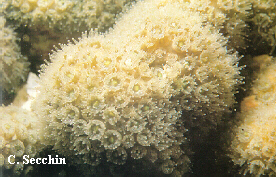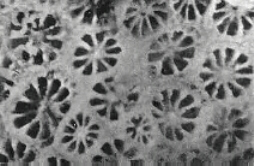Four different populations of Madracis decactis are described along the Brazilian coast: two photophilic populations, found at varying depths between 3 and 10 m, a shaded zone population, living at depths of 10 to 20 m, and a subreef population, found at depths greater than 30 m. The tropical shallow water forms are pyramidal, or columnar, and grow in successive crusts. They are thicker and denser than the colonies of populations of colder waters and their maximum diameter reaches 30 cm. The live colony is generally light brown. The shallow water populations found in the subtropical regions of Angra dos Reis and Ilha Grande (Rio de Janeiro) form dense colonies with


dichotomous lobes and those of the Ubatuba and São Sebastião (São Paulo) form light, fragile and little calcified colonies. The little calcified mid depth colonies (10 to 20 m), found along the coast of the Fernando de Noronha islands, are spherical, lobed, and have diameters of about 5 cm. The living colony is pale purple. The subreef form has purple encrusted colonies. The calice diameter varies between 1.0 and 1.5 mm. The photophilic population, in tropical regions, however, has larger calices than the subreef population and those in subtropical regions.